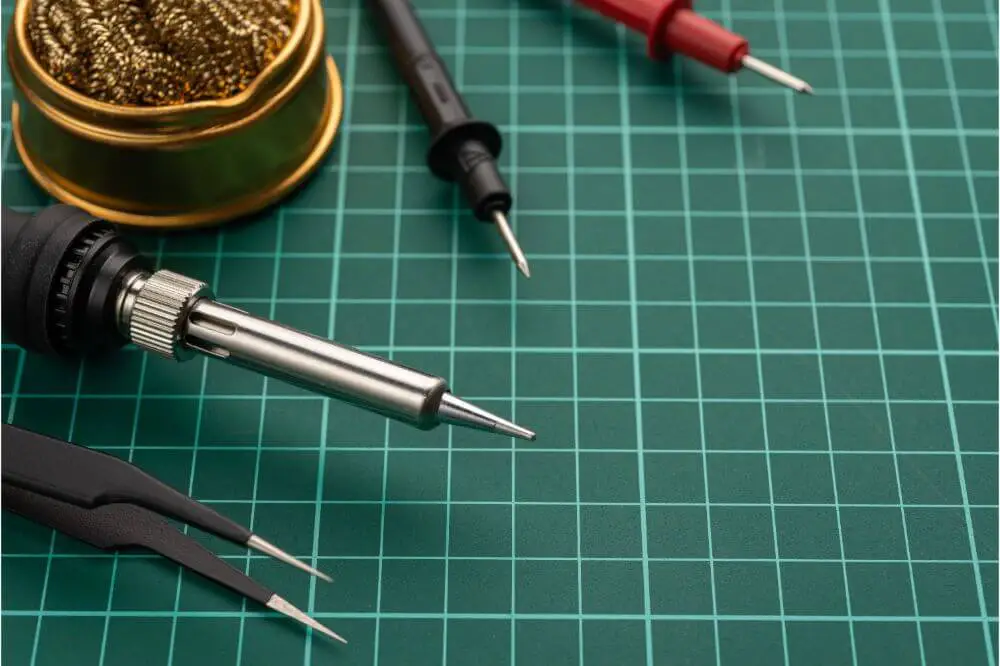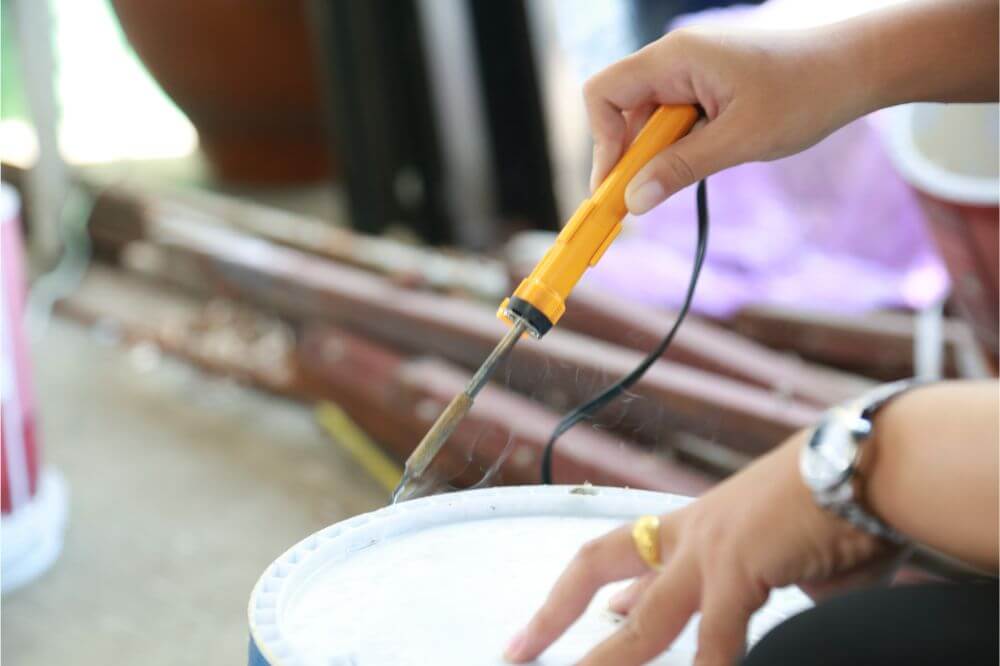Soldering is a handy skill to have…
It can be used for a variety of applications and you can get into small spaces very easily. The majority of soldering irons are not very large making them easy to hold and maneuver. Also,. soldering doesn’t usually take along time to do.
Different soldering irons are made of different metals but the basic elements remain the same. To find the construction materials used in creating the different soldering irons, just continue to read our article. It supplies that information and more so your soldering time is better than ever.
What is a soldering iron made of?
There are about 6 or 7 different soldering irons you can find in the stores. Each one has its own unique difference but basically the principle and materials are the same. Here is a table o help you see the construction materials as well as the differences between soldering iron types.
| Soldering iron type | Construction materials |
|---|---|
| Simple soldering iron | Metal chassis, metal heating element, wires to conduct electricity, insulation for the handle, plastic, and a power cord |
| Cordless soldering irons | Metal chassis, some wires to connect the battery or gas capsule to the heating element, metal heating element, plastic, insulation to protect your fingers |
| Temperature controlled soldering irons | The only real difference between this model and the simple soldering iron is that a plastic temperature control dial is added to the design |
| Soldering station | There is plastic for the body shell, heating elements,plastic for the dials or digital display, the latter will have LCD lighting, copper wires, power cords to the standard soldering iron and power cord to the outlet |
| Soldering tweezers | Plastic is used to form the handles and provide insulation, then metal to the two prongs which double as a heating element, there is also wires or power cord to bring the electricity to the tweezers |
| Hot knife | Metal for the double edged blade, metal for the heating iron, plastic for the handle and insulation, power cord |
What are soldering iron tips made from?
These accessories are a bit more simplified and use only 2 metals to create them. Copper is an excellent conductor of heat or electricity but that metal corrodes to easily and cannot be the sole metal used if you want the tips to last a long time.
Usually, all copper tips are iron plated to make sure they last you even under heavy use. When iron is used to plate the copper sometimes nickel is used in between the iron and copper layers to make sure the copper tip is well protected.
Sometimes, nickel chrome alloy is used back from the end of the tip as solder does not stick to this metal alloy. In some cases a tip may have a heat sensor to help regulate the temperature.
Those sensors are made from different heat resistant materials. Since nothing is forever, the iron tips will wear out and you will have to replace them eventually.

Different types of soldering
When it comes to soldering, you have three choices of styles to choose between. The style you select will be determined by your project and the components involved. Here are the details to help you select the right style for your project:
| Style of soldering | Temperature range | Application |
|---|---|---|
| Soft soldering | 200 to 1000 degrees F | For tasks requiring low metal melting points and often has lead in the solder. It forms the weakest bond restricting its application |
| Hard or silver soldering | 1000 degrees F & above | Usually brass and silver are used in this method of soldering. Plus, you may need a blow torch to get the high heat neededBrazing1000 degrees F and higherThis method works with metals that need filler material that has a higher melting point than soft or silver soldering |
The many uses of a soldering iron
Now that you know how soldering irons are made and what materials are used to create them, it is necessary to know the different uses these vital pieces of equipment have.
First a short list of the different industries that use soldering irons, then the list of uses.
#1. Industries that use soldering irons
- Construction or roofing
- Electronics, non computer
- Computer electronics
- Jewelry makers
- Artists, mostly in the stained glass industry
- Plumbing, but a blow torch is used instead of a soldering iron
#2. The many uses of a soldering iron
- Connecting gutter sections made with galvanized metal
- Connecting flashing to roofs and gutters
- Connect copper roofing materials
- Create stain glass or mosaic artwork together
- Building circuit boards for a myriad of applications
- Hold wire ends together or to components that need a steady flow of electricity
- Used in commercial and residential wiring situations
- Fuse wires together in electrical boxes or terminals
- Used to smooth out auto repairs, fill joints or connect wiring to their proper feature
- Tins metal sheets, fill gaps and fuse metal panels in car repairs
- Works great for home soldering projects or repair work
- Helps make artistic and traditional jewelry
- Seals vacuum tubes when necessary
- Join copper pipes together in plumbing tasks
What is flux made of?
Flux is an important part of soldering as it is used to clean away or prevent oxidation from forming on the metal tip or parts you are working with or on. There are three different components you can make flux from and they are:
- Hydrochloric acid
- Zinc chloride
- Rosin
Or you can make your own out of about 12 to 15 pine cones and 1 quart of Denatured Ethyl Alcohol
Some Final Words
Soldering irons are simple tools made in a very simple way. You just need to gather the parts together and connect them n the right order in order to make the iron work. A little mechanical know how is also important when connecting and lining up the different components.
But once you have your soldering iron, it is just a matter of plugging it in and waiting for it to heat up. After that you are good to go.

